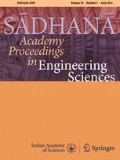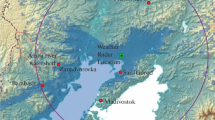Abstract
Traditionally, India has been vulnerable to various hazards such as floods, droughts and cyclones. About 8% of the total Indian landmass is prone to cyclones. A number of Doppler weather radars are installed in India and their products are utilized for weather predictions and detection of cyclones approaching the Indian coast. Radar-based hydrological studies in various countries have proven that computation of runoff using radar rainfall data could outperform rain gauge network measurements. There are no reported studies on their utilization for hydrological modelling and/or flood-related studies in Indian river basins. A comparison study between Doppler weather radar (DWR) derived rainfall data and the conventional rain gauge data was carried out with hourly inputs at one of the watersheds of Chennai basin, Tamil Nadu, India using HEC-HMS model. The model calibration and validation were performed by comparing the simulated outflow with the observed daily outflow data. The calibrated model was used to predict runoff from two post-monsoon cyclonic storm events with hourly inputs. It was noticed that the discrepancy in the runoff volume was small, but the difference in the peak flow was substantial. Additionally, there was a variation at the time to peak flow using daily and hourly inputs. The results show that the use of radar data may be optional for runoff volume estimation for the watersheds with sufficient rain gauge density, but highly desirable for peak flow and time to peak estimation. Therefore, the DWR derived rainfall data is a promising input for runoff estimation, especially in urban flood modelling.






Similar content being viewed by others
References
Bhatnagar A K, Rajesh R P, Kalyanasundaram S, Thampi S B, Suresh R and Gupta J P 2003 Doppler radar –A detecting tool and measuring instrument in meteorology. Curr. Sci. 85(3): 256–264
Bhowmik S K R, Roy S S, Srivastava K, Mukhopadhay B, Thampi S B, Reddy Y K, Singh H, Venkateswarlu S and Adhikary S 2011 Processing of Indian Doppler weather radar data for mesoscale applications. Meteorology and Atmospheric Phys. 111: 133–147
Guhathakurta P and Rajeevan M 2008 Trends in the rainfall pattern over India. Int. J. Climatol. 28: 1453–1469
Habib E, Qin L, Seo D, Ciach G J and Nelson B R 2013 Independent assessment of incremental complexity in NWS multisensor precipitation estimator algorithms. J. Hydrol. Eng. 18(2): 143–155
Hammouri N and El-Naqa A 2007 Hydrological modeling of ungauged wadis in arid environments using GIS: A case study of Wadi Madoneh in Jordan. Revista Mexicana de Ciencias Geológicas 24(2): 185–196
Jeremy G 2011 Peak flow and runoff volume estimation using historical weather radar maps. Proc. AECOM Manitoba, Canada
Kathol J, Werner H and Trooien T 2003 Predicting runoff for frequency based storms using a precipitation-runoff model. Proceedings of the North-Central Intersectional Meeting of the American Society of Agricultural Engineers (ASAE) and Canadian Society of Agricultural Engineers (CSAE), Fargo North Dakota: St. Joseph, MI, ASAE Paper RRV03-0046
Kitzmiller D, Miller D, Fulton R and Ding F 2013 Radar and multisensor precipitation estimation techniques in National Weather Service hydrologic operations. J. Hydrol. Eng. 18(2): 133–142
Knapp H V, Singh J and Andrew K 2007 Hydrologic modeling of climate scenarios for two Illinois watersheds. Watershed Science Section, Illinois State Water Survey, Project Report, 2004–07
Mapiam P P, Sharma A, Chumchean S and Sriwongsitanon N 2009 Runoff estimation using radar and rain gage data. 18th World IMACS/MODSIM Congress, Cairns, Australia
Mazari N, Xie H, Zeitler J and Sharif H 2013 Validation of the NEXRAD DSP product with a dense rain gauge network. J. Hydrol. Eng. 18(2): 156–167
Mazumdar A B, Khole M and Devi S S 2009 Cyclones and depression over the North Indian Ocean during 2009. MAUSAM 61(3): 271–290
Mohan S, Raman H and Srinivasaraju K 1999 Flood Simulation in Adyar river system, in Inland water resources, India. (Eds) Durga Prasad M K and Pitchaiah P S, New Delhi: Discovery Publishing House, 330–339
Pathak C 2013 Special issue on radar rainfall data analyses and applications. J. Hydrol. Eng. 18(2): 131–132
Rashid M M, Faruque S B and Alam J B 2012 Modeling of Short Duration Rainfall Intensity Duration Frequency (SDRIDF) equation for Sylhet City in Bangladesh. ARPN. J. Sci. Technol. 2: 92–95
Roy S S, Lakshmanan V, Bhowmik S K R and Thampi S B 2010 Doppler weather radar based nowcasting of cyclone Ogni. J. Earth Syst. Sci. 119(2): 183–199
Ruiz-Villanueva V, Borga M, Zoccatelli D, Marchi L, Gaume E and Ehret U 2012 Extreme flood response to short-duration convective rainfall in South-West Germany. Hydrology and Earth Sci. Syst. 16: 1543–1559
Sarkar S K and Kumar A 2007 Recent studies on cloud and precipitation phenomena for propagation characteristics over India. Indian J. Radio and Space Phys. 36: 502–513
Suresh R 2012 Forecasting and nowcasting convective weather phenomena over southern peninsula India - Part I: Thunderstorms. Indian J. Radio and Space Phys. 41: 421–434
Suresh R 2010 Radar hydrology and rainfall mapping. Proceedings of the national seminar on Doppler Radar and Weather Surveillance (DRaWS-2010), Regional Meteorological Centre, Chennai, India
Suresh R, Ravichandran P K, Gupta J P, Thampi S B, Kalyanasundaram S and Rajesh R P 2005 On optimum rain rate estimation from a pulsed Doppler weather radar at Chennai. MAUSAM 56: 433–446
Suriya S and Mudgal B V 2012 Impact of urbanization on flooding: The Thirusoolam sub watershed – A case study. J. Hydrol. 412–413: 210–219
Teague A, Christian J and Bedient P 2013 Radar Rainfall Application in Distributed Hydrologic Modeling for Cypress Creek Watershed. Texas. J. Hydrol. Eng. 18(2): 219–227
USACE (United States Army Corps of Engineers) 2009 HEC Data Storage System Visual Utility Engine: HEC-DSSVue User’s manual. Version 2.0
USACE (United States Army Corps of Engineers) 2010 Hydrologic Modeling System: HEC-HMS User manual. Version 3.5
Author information
Authors and Affiliations
Corresponding author
Rights and permissions
About this article
Cite this article
JOSEPHINE, V.S., MUDGAL, B.V. & THAMPI, S.B. Applicability of Doppler weather radar based rainfall data for runoff estimation in Indian watersheds – A case study of Chennai basin. Sadhana 39, 989–997 (2014). https://doi.org/10.1007/s12046-014-0258-1
Received:
Revised:
Accepted:
Published:
Issue Date:
DOI: https://doi.org/10.1007/s12046-014-0258-1




